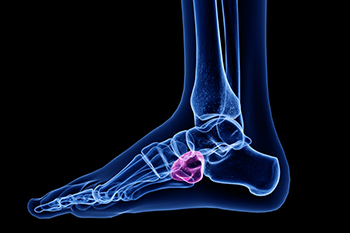
Cuboid syndrome is a condition that affects the foot, specifically the cuboid bone, located on the outer side of the midfoot. It happens when the cuboid and calcaneus joint move abnormally, causing misalignment or limited movement. This misalignment can result from sudden trauma, repetitive stress, or uneven gait, often seen in athletes or individuals with poor foot mechanics. The symptoms of cuboid syndrome include pain, swelling, and difficulty walking. The pain may worsen with running, jumping, or standing for long periods. Some people may also experience a feeling of weakness or instability in the foot. Proper diagnosis and treatment, such as manual manipulation, can help realign the cuboid bone and restore normal foot function. If you have pain in your foot, it is strongly suggested that you visit a chiropodist who can provide a proper diagnosis and treatment.
Cuboid syndrome, also known as cuboid subluxation, occurs when the joint and ligaments surrounding the cuboid bone in the foot become injured. If you think that you may have cuboid syndrome, please consult with Paul A. Scotti, D.Ch from West Toronto Foot & Ankle Clinic Inc. . Our chiropodist will assess your condition and provide you with quality foot and ankle treatment.
Causes
The cuboid bone is one of the seven tarsal bones located in the foot. Cuboid syndrome develops when the cuboid bone moves down and out of alignment with the other bone (calcaneus bone) in the joint of the foot. Cuboid syndrome can be the result of a sudden injury like an ankle sprain, or it may develop slowly over time from repetitive tension through the bone and surrounding structures.
Symptoms
The most common symptom of cuboid syndrome is pain on the outside of the foot which may worsen with activity.
Other possible symptoms include:
Difficulty bearing weight on the affected foot
Swelling
Sensitivity on the bottom of the foot
Reduced range of motion
Diagnosis
A chiropodist can diagnose cuboid syndrome based on your medical history and a physical examination of the foot. Imaging studies, such as X-rays or MRIs, often fail to show the dislocated cuboid.
Treatment
Treatment often includes resting, icing, compressing and elevating the affected foot, taping, wearing orthotic inserts, and taking anti-inflammatory medications to reduce pain. The chiropodist may also be able to manipulate the dislocated bone back into alignment.
If you have any questions, please feel free to contact our office located in . We offer the newest diagnostic and treatment technologies for all your foot care needs.
